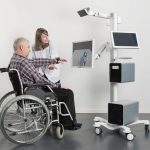 I wrote recently about the growing use of virtual reality in areas such as rehabilitation. Immersive Rehab is a British startup that is using virtual reality to help people rehabilitate themselves after injury.
I wrote recently about the growing use of virtual reality in areas such as rehabilitation. Immersive Rehab is a British startup that is using virtual reality to help people rehabilitate themselves after injury.
They wanted to make rehab a more accessible and engaging process, both to start and then to maintain. The process is especially challenging for stroke patients and those with limited mobility, as they struggle to engage with physical objects.
Immersive Rehab aim to help these people by offering both neurological and physical rehab in a virtual environment. Users perform the same kind of movements they would attempt in physical rehab, but they are grabbing and interacting with items virtually. The idea is that they trick the brain into thinking they are engaging with real objects, and thus make important gains in their mobility.
Accelerating stroke recovery
Another company operating along similar lines is MindMaze, who use virtual reality to aid recovery from strokes. The company have recently announced FDA approval and therefore plans to roll-out across America.
The company believe their VR based system leads to higher engagement rates, thus helping people to get the rehab they require. The system comes with an AI driven back-end that adjusts the environment users experience based upon the level of stroke injury.
Getting better at this is crucial as around 800,000 people suffer from a stroke each year in the United States alone. The MindMaze system has undergone considerable development and is based on peer-reviewed research into the most effective way to recover from strokes.
Next generation rehab
The latest iteration of the product recently secured FDA level 2 clearance in the United States. The system uses 3D motion tracking cameras to capture the movements of the patient and map them across to a 3D avatar. This avatar is then coached through a series of rehabilitation exercises that are based on standardized neurorehabilitation principles of upper limb rehabilitation & cognitive paradigms.
As with other VR based rehab applications, the aim is to trick the brain into reactivating damaged neurons, or alternatively recruit new ones to replace the damaged ones.
“Our work at the forefront of neuroscience and virtual reality has allowed hundreds of patients to recover faster and return more fully to the life they lived before injury. We are excited to further our recovery reach in the US, where 800,000 people experience a stroke each year,” MindMaze founder Tej Tadi told me recently.
Check out the system in action via the video below.
Of course, it’s not just MindMaze that are tackling this crucial area. Another fascinating startup is Neurofenix, who have developed a hand controller that’s connected to an app. The system is designed to help stroke survivors to perform the exercises recommended by their therapist.
Stroke survivors place their hand on top of the controller and can train their whole upper limb, from fingers to shoulder. It also has the potential to help with other physical and cognitive issues, such as brain injury or cerebral palsy. The controller – called the GameBall Platform – will launch in the UK in 2018.
Along similar lines is MIRA, who I wrote about last year. They utilize the video technology found in the Microsoft Kinect to guide users through exercises via a series of game interfaces.
“I’ve always been quite fit and tried to exercise, but as I got older I found that I could quite easily lose my balance when I turn. For me, Exergames provided a structure to encourage me to exercise more regularly. I found that as a result I could get up more easily after kneeling down. I feel healthy and positive that I’m doing something to help prevent problems that might otherwise occur,” one of the participants said.
Rehab is one of those hugely important areas that can often slip under the radar with regards to new technologies, but these three examples highlight some of the fascinating work being done. It will be great to watch the progress each makes.